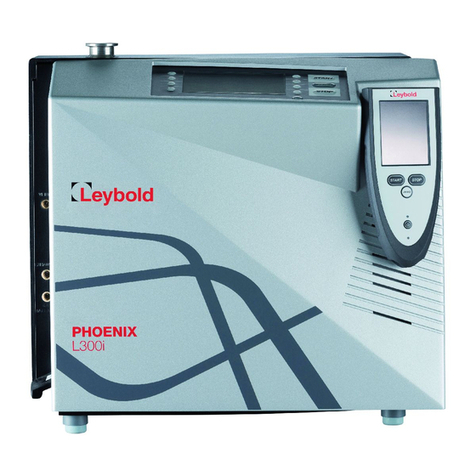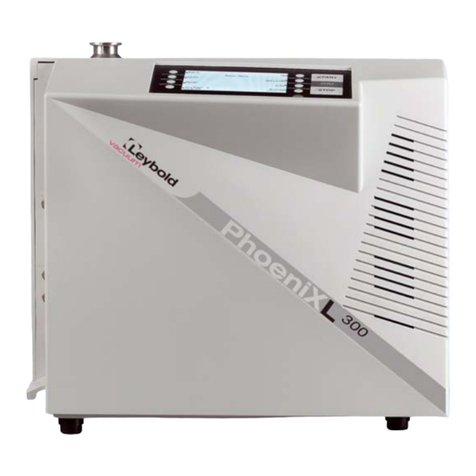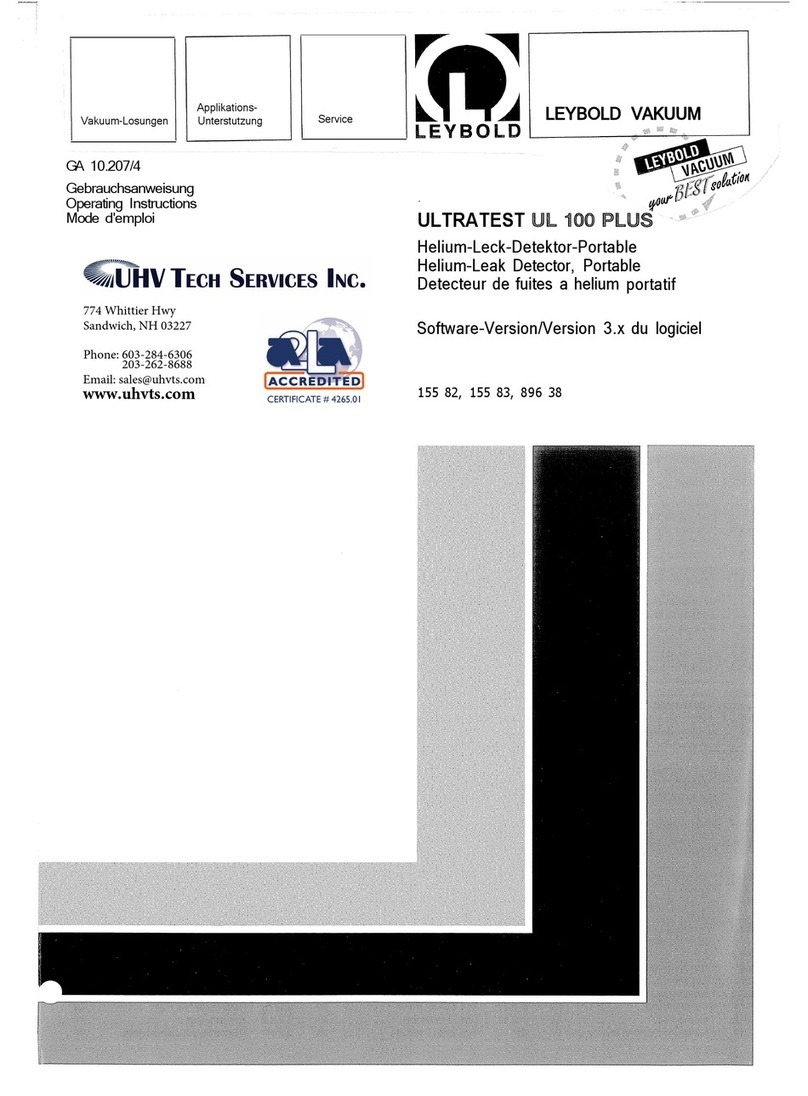Leybold Service
If equipment is returned to LEYBOLD, indicate whether
the equipment is free of substances damaging to health
or whether it is contaminated. If it is contaminated also
indicate the nature of the hazard. LEYBOLD must return
any equipment without a Declaration of Contaminationî
to the sender’s address (refer also to Chapter 3.1).
General
We reserve the right to alter the design or any data given
in this handbook.
The illustrations are not binding.
Notes on how to use this handbook
Important remarks concerning operational safety and
protection are emphasized as follows:
Warning Indicates procedures that must be strict-
ly observed to prevent hazards to per-
sons.
Caution Indicates procedures that must strictly
be observed to prevent damage to, or
destruction of the UL 200 helium leak
detector.
Note
Indicates special requirements the user must comply
with.
The references to diagrams, e.g. (2/5) consist of the Fig.
No. and the Item No. in that order.
Contents Page
1 Description . . . . . . . . . . . . . . . . . . . . . . . . . 3
1.1 General information . . . . . . . . . . . . . . . . . . . 3
1.1.1 Purpose . . . . . . . . . . . . . . . . . . . . . . . . . . . . 3
1.2 Technical data . . . . . . . . . . . . . . . . . . . . . . . . 3
1.2.1 Physical data . . . . . . . . . . . . . . . . . . . . . . . . 3
1.2.2 Electrical data . . . . . . . . . . . . . . . . . . . . . . . . 3
1.2.3 Other data . . . . . . . . . . . . . . . . . . . . . . . . . . 4
1.3 Equipment . . . . . . . . . . . . . . . . . . . . . . . . . . 4
1.3.1 Supplied equipment . . . . . . . . . . . . . . . . . . . 4
1.3.2 Accessories . . . . . . . . . . . . . . . . . . . . . . . . . 4
1.4 Technical description . . . . . . . . . . . . . . . . . . . 5
1.4.1 Forevacuum pump . . . . . . . . . . . . . . . . . . . . 5
1.4.2 Turbomolecular pump . . . . . . . . . . . . . . . . . . 5
Page
1.4.3 Mass spectrometer . . . . . . . . . . . . . . . . . . . . 5
1.4.4 Ion source . . . . . . . . . . . . . . . . . . . . . . . . . . 5
1.4.5 Separation system . . . . . . . . . . . . . . . . . . . . 6
1.4.6 Ion collector . . . . . . . . . . . . . . . . . . . . . . . . . 6
1.4.7 Electrometer amplifier . . . . . . . . . . . . . . . . . . 6
1.4.8 Mass spectrometer supply . . . . . . . . . . . . . . 6
1.4.9 Control . . . . . . . . . . . . . . . . . . . . . . . . . . . . . 6
1.4.10 Operation and remote control . . . . . . . . . . . . 6
1.5 Description of the functions of the UL 200 . . . 7
1.5.1 Vacuum Method . . . . . . . . . . . . . . . . . . . . . . 7
1.5.2 Partial Flow Method . . . . . . . . . . . . . . . . . . . 7
1.5.3 Sniffer Mode . . . . . . . . . . . . . . . . . . . . . . . . . 7
2 Operation . . . . . . . . . . . . . . . . . . . . . . . . . . 8
2.1 Installation of the instrument . . . . . . . . . . . . 10
2.1.1 Installation . . . . . . . . . . . . . . . . . . . . . . . . . 10
2.1.2 Preparations for initial start-up . . . . . . . . . . . 10
2.2 Electrical connections . . . . . . . . . . . . . . . . . 10
2.3 Start-up (first pump-down cycle) . . . . . . . . . 11
2.4 The controls and their functions . . . . . . . . . 12
2.4.1 Overview of the controls and displays . . . . . 12
2.4.2 The mains switch . . . . . . . . . . . . . . . . . . . . 12
2.4.3 Controls on the control panel . . . . . . . . . . . 12
2.4.4 Controls on the hand unit . . . . . . . . . . . . . . 13
2.4.5 Displays on the hand unit . . . . . . . . . . . . . . 14
2.5 Equipment settings (menu structure) . . . . . . 15
2.5.1 Entry of equipment parameters . . . . . . . . . . 15
2.5.2 Password . . . . . . . . . . . . . . . . . . . . . . . . . . 15
2.5.3 Menu functions (overview) . . . . . . . . . . . . . . 16
2.5.4 Description of the individual menu functions 16
2.6 Equipment connections . . . . . . . . . . . . . . . . 27
2.6.1 RS 232 C interface (SERIAL) . . . . . . . . . . . 27
2.6.2 Chart recorder outputs (RECORDER) . . . . . 27
2.6.3 Control inputs and outputs (CONTROL) . . . 27
2.6.4 Connection for accessories (OPTION) . . . . . 28
2.7 Calibration . . . . . . . . . . . . . . . . . . . . . . . . . 28
2.7.1 Internal calibration . . . . . . . . . . . . . . . . . . . . 28
2.7.2 External calibration . . . . . . . . . . . . . . . . . . . 29
2.7.3 External calibration for sniffer applications . . 29
2.8 Shutdown . . . . . . . . . . . . . . . . . . . . . . . . . . 30
3 Maintenance . . . . . . . . . . . . . . . . . . . . . . . 31
3.1 LEYBOLD service . . . . . . . . . . . . . . . . . . . . 31
3.2 Maintenance plan . . . . . . . . . . . . . . . . . . . . 31
3.2.1 Opening the UL 200 . . . . . . . . . . . . . . . . . . 31
3.2.2 Exchanging the filter mats . . . . . . . . . . . . . . 32
3.2.3 Exchanging the oil . . . . . . . . . . . . . . . . . . . 32
3.2.4 Cleaning . . . . . . . . . . . . . . . . . . . . . . . . . . . 33
3.2.5 Exchanging the fuses . . . . . . . . . . . . . . . . . 33
4 Messages . . . . . . . . . . . . . . . . . . . . . . . . . 35
4.1 Equipment messages . . . . . . . . . . . . . . . . . 35
4.2 Warnings and error messages . . . . . . . . . . . 37
4.2.1 Warnings . . . . . . . . . . . . . . . . . . . . . . . . . . 37
4.2.2 Error messages . . . . . . . . . . . . . . . . . . . . . 37
4.2.3 List of all warnings and error messages . . . 38
5 Definition of terms . . . . . . . . . . . . . . . . . . 42
2TH 10.211/8.02 - 12/97






























